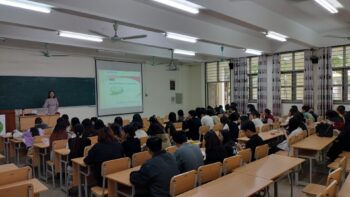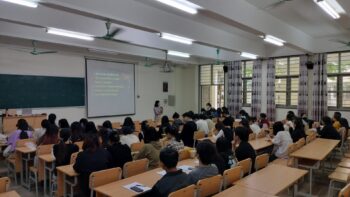On December 9th, 2023, the seminars entitled “Research designs: Guidelines for K65 English Majors at Vietnam National University of Agriculture” and “A Brief Introduction to Contrastive Linguistics” were presented by Dr. Nguyen Thi Thu Thuy – a senior lecturer of Department of Professional English, Faculty of Tourism & Foreign Languages, VNUA. All K65 English majored students and teachers of Faculty of Tourism & Foreign Languages attended the seminars held in ND104.

Dr. Nguyen Thi Thu Thuy presented
The first seminar with the title “Research designs: Guidelines for K65 English Majors at Vietnam National University of Agriculture (VNUA)” focused on presenting a mixed methods research design which can be defined as a procedure for collecting, analyzing, and ‘mixing’ both qualitative and quantitative data in a single study to understand a research problem (Brewer & Hunter, 1989). The reason why I conveyed this topic is that recently, most of English majored students at VNUA have chosen a mixed methods research design to conduct their graduation papers. Therefore, I shared with K65 English majors the basic definition, characteristics, classifications and procedures of mixed methods design so as to help them to write their graduation thesis well. If students use this design, they need to understand both qualitative and quantitative research. While the former can be described as ‘research which uses procedures that make use of QUALITATIVE DATA, such as observations, interviews, or PARTICIPANT OBSERVATION’ and the latter may be defined as ‘research which uses procedures which gather data in numerical form’ (Richards, et al., 1992, p. 302-303). The main difference between these two approaches lies in the fact that qualitative research uses words rather than numbers (quantitative), or better yet, uses open-ended questions and responses (qualitative interview questions) and quantitative research uses closed-ended questions and responses (quantitative hypotheses). Therefore, it is useful to convey a complete set of core characteristics that describe mixed methods. This might include (i) the collection of both qualitative (open-ended) and quantitative (closed-ended) data in response to research questions or hypotheses, (ii) the rigorous methods (i.e., data collection, data analysis, and interpretation) of both quantitative and qualitative data, (iii) The two forms of data are integrated in the design analysis through merging the data, explaining the data, building from one database to another, or embedding the data within a larger framework, and (iv) These procedures are incorporated into a distinct mixed methods design that indicates the procedures to be used in a study. (Johnson, Onwuegbuzie, & Turner, 2007).


The second seminar entitled “A Brief Introduction to Contrastive Linguistics” delves into the definition of Contrastive Linguistics/ Analysis, the importance of contrastive analysis (CA), the contrastive analysis hypothesis (CAH), the concepts of positive and negative transference and interference, and what to compare between two languages. CA is a branch of applied linguistics that is concerned with studying and finding the similarities and differences between a pair of languages or more based on the assumption that languages can be compared then applying these findings to the area of teaching and learning languages. Fisiak (1981) defines CA as a sub-discipline of linguistics concerned with the comparison of two or more languages or subsystems of language in order to determine both the differences and similarities between them. The term transfer/interference is dealt with in CA to explain the difficulties learners face in learning a second language. To avoid any misunderstanding, transfer is used interchangeably with interference. Transfer refers to the influence of L1 on L2 in both positive and negative way. Odlin (1989) presents a definition of transfer as “The influence resulting from the similarities and differences between the target language and any other language that has been previously acquired.” Positive transfer occurs where a language item in L1 is also present in L2, so acquisition of this item makes little or no difficulty for the learners. Negative transfer occurs when there is no concordance between L1 and L2 and thus, acquisition of the new L2 structure would be more difficult and errors reflecting L1 structure would be produced. (Powell, 1998).
During the seminars, the participants including teachers and students discussed actively & enthusiastically issues concerning how to choose appropriate methods to accomplish the graduation thesis, how to avoid plagiarism in academic writing, how to compare and contrast two cultures (e.g., English and Vietnamese).


 Tiếng Việt
Tiếng Việt